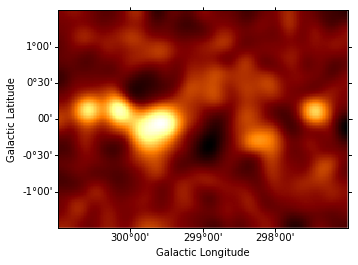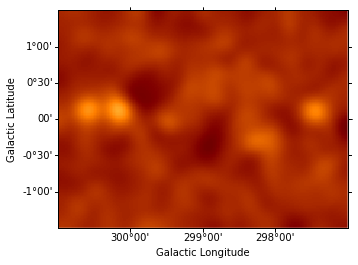This is a fixed-text formatted version of a Jupyter notebook.
- Try online
- You can contribute with your own notebooks in this GitHub repository.
- Source files: image_fitting_with_sherpa.ipynb | image_fitting_with_sherpa.py
Fitting 2D images with Sherpa¶
Introduction¶
Sherpa is the X-ray satellite Chandra modeling and fitting application. It enables the user to construct complex models from simple definitions and fit those models to data, using a variety of statistics and optimization methods. The issues of constraining the source position and morphology are common in X- and Gamma-ray astronomy. This notebook will show you how to apply Sherpa to CTA data.
Here we will set up Sherpa to fit the counts map and loading the ancillary images for subsequent use. A relevant test statistic for data with Poisson fluctuations is the one proposed by Cash (1979). The simplex (or Nelder-Mead) fitting algorithm is a good compromise between efficiency and robustness. The source fit is best performed in pixel coordinates.
Read sky images¶
The sky image that are loaded here have been prepared in a separated notebook. Here we start from those fits file and focus on the source fitting aspect.
The info needed for sherpa are: - Count map - Background map - Exposure map - PSF map
For info, the fits file are written in the following way in the Sky map generation notebook:
images['counts'] .write("G300-0_test_counts.fits", clobber=True)
images['exposure'] .write("G300-0_test_exposure.fits", clobber=True)
images['background'].write("G300-0_test_background.fits", clobber=True)
##As psf is an array of quantities we cannot use the images['psf'].write() function
##all the other arrays do not have quantities.
fits.writeto("G300-0_test_psf.fits",images['psf'].data.value,overwrite=True)
In [1]:
%matplotlib inline
import matplotlib.pyplot as plt
import numpy as np
from astropy.coordinates import SkyCoord
import astropy.units as u
from astropy.io import fits
from astropy.wcs import WCS
from gammapy.maps import Map, WcsNDMap, WcsGeom
import os
# Warnings about XSPEC or DS9 can be ignored here
import sherpa.astro.ui as sh
WARNING: imaging routines will not be available,
failed to import sherpa.image.ds9_backend due to
'RuntimeErr: DS9Win unusable: Could not find ds9 on your PATH'
WARNING: failed to import sherpa.astro.xspec; XSPEC models will not be available
In [2]:
# Read the fits file to load them in a sherpa model
filecounts = os.environ["GAMMAPY_DATA"] + "/sherpaCTA/G300-0_test_counts.fits"
hdr = fits.getheader(filecounts)
wcs = WCS(hdr)
sh.set_stat("cash")
sh.set_method("simplex")
sh.load_image(filecounts)
sh.set_coord("logical")
fileexp = os.environ["GAMMAPY_DATA"] + "/sherpaCTA/G300-0_test_exposure.fits"
filebkg = os.environ["GAMMAPY_DATA"] + "/sherpaCTA/G300-0_test_background.fits"
filepsf = os.environ["GAMMAPY_DATA"] + "/sherpaCTA/G300-0_test_psf.fits"
sh.load_table_model("expo", fileexp)
sh.load_table_model("bkg", filebkg)
sh.load_psf("psf", filepsf)
In principle one might first want to fit the background amplitude. However the background estimation method already yields the correct normalization, so we freeze the background amplitude to unity instead of adjusting it. The (smoothed) residuals from this background model are then computed and shown.
In [3]:
sh.set_full_model(bkg)
bkg.ampl = 1
sh.freeze(bkg)
resid = Map.read(filecounts)
resid.data = sh.get_data_image().y - sh.get_model_image().y
resid_smooth = resid.smooth(width=6)
resid_smooth.plot();

Find and fit the brightest source¶
We then find the position of the maximum in the (smoothed) residuals map, and fit a (symmetrical) Gaussian source with that initial position:
In [4]:
yp, xp = np.unravel_index(
np.nanargmax(resid_smooth.data), resid_smooth.data.shape
)
ampl = resid_smooth.get_by_pix((xp, yp))[0]
sh.set_full_model(
bkg + psf(sh.gauss2d.g0) * expo
) # creates g0 as a gauss2d instance
g0.xpos, g0.ypos = xp, yp
sh.freeze(g0.xpos, g0.ypos) # fix the position in the initial fitting step
expo.ampl = (
1e-9
) # fix exposure amplitude so that typical exposure is of order unity
sh.freeze(expo)
sh.thaw(g0.fwhm, g0.ampl) # in case frozen in a previous iteration
g0.fwhm = 10 # give some reasonable initial values
g0.ampl = ampl
In [5]:
%%time
sh.fit()
Dataset = 1
Method = neldermead
Statistic = cash
Initial fit statistic = 47566.1
Final fit statistic = 47440.7 at function evaluation 228
Data points = 30000
Degrees of freedom = 29998
Change in statistic = 125.402
g0.fwhm 20.0951
g0.ampl 0.111272
CPU times: user 1.58 s, sys: 17 ms, total: 1.6 s
Wall time: 1.62 s
Fit all parameters of this Gaussian component, fix them and re-compute the residuals map.
In [6]:
sh.thaw(g0.xpos, g0.ypos)
sh.fit()
sh.freeze(g0)
resid.data = sh.get_data_image().y - sh.get_model_image().y
resid_smooth = resid.smooth(width=6)
resid_smooth.plot(vmin=-0.5, vmax=1);
Dataset = 1
Method = neldermead
Statistic = cash
Initial fit statistic = 47440.7
Final fit statistic = 47429.2 at function evaluation 408
Data points = 30000
Degrees of freedom = 29996
Change in statistic = 11.4937
g0.fwhm 21.5373
g0.xpos 66.3947
g0.ypos 69.3172
g0.ampl 0.107149

Iteratively find and fit additional sources¶
Instantiate additional Gaussian components, and use them to iteratively fit sources, repeating the steps performed above for component g0. (The residuals map is shown after each additional source included in the model.) This takes some time…
In [7]:
# initialize components with fixed, zero amplitude
for i in range(1, 6):
model = sh.create_model_component("gauss2d", "g" + str(i))
model.ampl = 0
sh.freeze(model)
gs = [g0, g1, g2, g3, g4, g5]
sh.set_full_model(bkg + psf(g0 + g1 + g2 + g3 + g4 + g5) * expo)
In [8]:
%%time
for i in range(1, len(gs)):
yp, xp = np.unravel_index(
np.nanargmax(resid_smooth.data), resid_smooth.data.shape
)
ampl = resid_smooth.get_by_pix((xp, yp))[0]
gs[i].xpos, gs[i].ypos = xp, yp
gs[i].fwhm = 10
gs[i].ampl = ampl
sh.thaw(gs[i].fwhm)
sh.thaw(gs[i].ampl)
sh.fit()
sh.thaw(gs[i].xpos)
sh.thaw(gs[i].ypos)
sh.fit()
sh.freeze(gs[i])
resid.data = sh.get_data_image().y - sh.get_model_image().y
resid_smooth = resid.smooth(width=6)
resid_smooth.plot(vmin=-0.5, vmax=1)
Dataset = 1
Method = neldermead
Statistic = cash
Initial fit statistic = 47352.1
Final fit statistic = 47306.6 at function evaluation 218
Data points = 30000
Degrees of freedom = 29998
Change in statistic = 45.4492
g1.fwhm 6.73141
g1.ampl 0.358694
Dataset = 1
Method = neldermead
Statistic = cash
Initial fit statistic = 47306.6
Final fit statistic = 47295.3 at function evaluation 362
Data points = 30000
Degrees of freedom = 29996
Change in statistic = 11.3247
g1.fwhm 5.88307
g1.xpos 41.7803
g1.ypos 81.4247
g1.ampl 0.45753
Dataset = 1
Method = neldermead
Statistic = cash
Initial fit statistic = 47211.4
Final fit statistic = 47187.6 at function evaluation 215
Data points = 30000
Degrees of freedom = 29998
Change in statistic = 23.794
g2.fwhm 6.77442
g2.ampl 0.346582
Dataset = 1
Method = neldermead
Statistic = cash
Initial fit statistic = 47187.6
Final fit statistic = 47184.1 at function evaluation 341
Data points = 30000
Degrees of freedom = 29996
Change in statistic = 3.46844
g2.fwhm 6.19417
g2.xpos 20.8277
g2.ypos 81.6412
g2.ampl 0.399908
Dataset = 1
Method = neldermead
Statistic = cash
Initial fit statistic = 47173.4
Final fit statistic = 47116.6 at function evaluation 227
Data points = 30000
Degrees of freedom = 29998
Change in statistic = 56.7946
g3.fwhm 6.43218
g3.ampl 0.235481
Dataset = 1
Method = neldermead
Statistic = cash
Initial fit statistic = 47116.6
Final fit statistic = 47115.9 at function evaluation 303
Data points = 30000
Degrees of freedom = 29996
Change in statistic = 0.728928
g3.fwhm 6.38175
g3.xpos 177.458
g3.ypos 80.2233
g3.ampl 0.239637
Dataset = 1
Method = neldermead
Statistic = cash
Initial fit statistic = 47121
Final fit statistic = 47090.2 at function evaluation 246
Data points = 30000
Degrees of freedom = 29998
Change in statistic = 30.818
g4.fwhm 7.24022
g4.ampl 0.112126
Dataset = 1
Method = neldermead
Statistic = cash
Initial fit statistic = 47090.2
Final fit statistic = 47087.3 at function evaluation 330
Data points = 30000
Degrees of freedom = 29996
Change in statistic = 2.93503
g4.fwhm 5.94179
g4.xpos 135.942
g4.ypos 59.5875
g4.ampl 0.156213
Dataset = 1
Method = neldermead
Statistic = cash
Initial fit statistic = 47082.3
Final fit statistic = 47068.5 at function evaluation 249
Data points = 30000
Degrees of freedom = 29998
Change in statistic = 13.7724
g5.fwhm 3.07232
g5.ampl 0.479624
Dataset = 1
Method = neldermead
Statistic = cash
Initial fit statistic = 47068.5
Final fit statistic = 47068.5 at function evaluation 320
Data points = 30000
Degrees of freedom = 29996
Change in statistic = 0.0196613
g5.fwhm 3.05445
g5.xpos 76.0488
g5.ypos 73.1002
g5.ampl 0.483818
CPU times: user 25.7 s, sys: 267 ms, total: 26 s
Wall time: 26.3 s

Generating output table and Test Statistics estimation¶
When adding a new source, one need to check the significance of this new source. A frequently used method is the Test Statistics (TS). This is done by comparing the change of statistics when the source is included compared to the null hypothesis (no source ; in practice here we fix the amplitude to zero).
\(TS = Cstat(source) - Cstat(no source)\)
The criterion for a significant source detection is typically that it should improve the test statistic by at least 25 or 30. The last excess fitted (g5) thus not a significant source:
In [9]:
from astropy.stats import gaussian_fwhm_to_sigma
from astropy.table import Table
rows = []
for g in gs:
ampl = g.ampl.val
g.ampl = 0
stati = sh.get_stat_info()[0].statval
g.ampl = ampl
statf = sh.get_stat_info()[0].statval
delstat = stati - statf
geom = resid.geom
coord = geom.pix_to_coord((g.xpos.val, g.ypos.val))
pix_scale = geom.pixel_scales.mean().deg
sigma = g.fwhm.val * pix_scale * gaussian_fwhm_to_sigma
rows.append(
dict(delstat=delstat, glon=coord[0], glat=coord[1], sigma=sigma)
)
table = Table(rows=rows, names=rows[0])
for name in table.colnames:
table[name].format = ".5g"
table
Out[9]:
| delstat | glon | glat | sigma |
|---|---|---|---|
| float64 | float64 | float64 | float64 |
| 156.52 | 299.66 | -0.10365 | 0.18292 |
| 133.86 | 300.15 | 0.13847 | 0.049966 |
| 111.18 | 300.57 | 0.14277 | 0.052608 |
| 68.202 | 297.44 | 0.11442 | 0.054202 |
| 28.633 | 298.27 | -0.29822 | 0.050465 |
| 18.816 | 299.47 | -0.027994 | 0.025942 |
Exercises¶
- If you look back to the original image: there’s one source that looks
like a shell-type supernova remnant.
- Try to fit is with a shell morphology model (use
sh.shell2d('shell')to create such a model). - Try to evaluate the
TSand probability of the shell model compared to a Gaussian model hypothesis - You could also try a disk model (use
sh.disk2d('disk')to create one)
- Try to fit is with a shell morphology model (use
What next?¶
These are good resources to learn more about Sherpa:
- https://python4astronomers.github.io/fitting/fitting.html
- https://github.com/DougBurke/sherpa-standalone-notebooks
You could read over the examples there, and try to apply a similar analysis to this dataset here to practice.
If you want a deeper understanding of how Sherpa works, then these proceedings are good introductions: